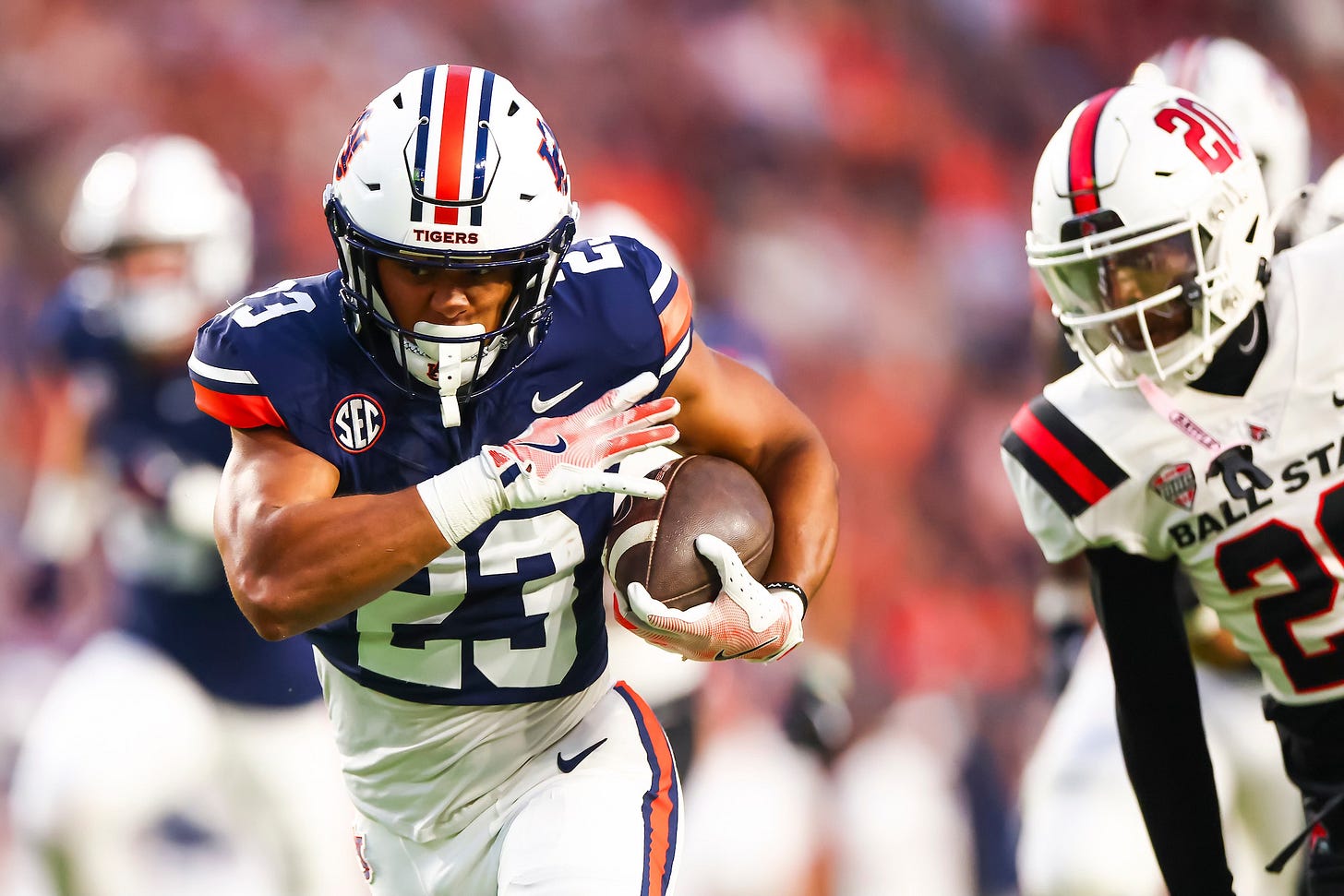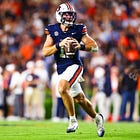Mailbag 220: Should you buy into Auburn's early rushing success?
This week: Stormtroopers, the defense, third-and-long, special teams, Omar Mabson, first-time opponents, Steven Pearl and a recipe
AUBURN — Welcome back to the mailbag. Space is limited this week, because enough of you asked me to put a full-scale recipe at the end of this.
So let’s begin with a quick introduction. I can’t believe we’re about to be, basically, a fourth of the way through Auburn football season. It felt like I was at SEC Media Days last week. It felt like I was at the Final Four the week before that.
(Speaking of which, we’ve got a big basketball question toward the end of this.)
But time flies when you’re having fun, and covering this new-look Auburn football team has been fun so far. However, I would caution that we don’t quite now how much better the Tigers might be — because the real tests are coming up here shortly, after a visit from an upset-minded and potentially tricky South Alabama team.
As always, we’ll try to keep the takes level-headed as possible here. Let’s go.
The vibe in fall camp was that the Auburn offense looked good, but struggled to score in the red zone due to struggling to run the ball consistently. Through two games, the ground game has been the highlight for the Auburn offense.
Do you chalk that up to the opponents’ front sevens? Jackson Arnold being able o go live and space out opponents? The Auburn defensive front being REALLY good?
Ryan
It has long been my belief that one of the biggest reasons why Auburn had a historically bad red-zone offense against quality competition last season — the worst at scoring touchdowns there in the SEC since that 0-8 Tennessee team — was because it could not run the ball in tight situations.
Even though Jarquez Hunter and the Tigers had been a fairly successful red-zone rushing attack in 2023, they were far from it in 2024. Auburn ranked 117th nationally inside the 20s last year with just 1.86 yards per carry. Combine that with a passing attack that was boom-or-bust in explosiveness and lacked real efficiency, and you’ve got an offense that is going to crumble more than it cruises in the red zone.
Through two games in 2025, Auburn is getting different results with different personnel. The Tigers are a perfect 5-for-5 in the red zone so far this season, with four touchdowns and just one field goal. That lone kick was a chip shot after Auburn got a first-and-goal from the 10 and tried a fade to Cam Coleman immediately. They’re No. 4 nationally in red-zone rushing right now, averaging 5.67 yards per carry.
The sample sizes are small, yes. But Auburn is toting the rock well, even with the departure of Hunter and the injuries for Damari Alston and, now, Durell Robinson. Auburn is No. 17 nationally in rushing offense from anywhere on the field and has already scored seven times on the ground. That’s more than half the amount Auburn had in 12 games last season, and only nine teams nationally have more right now.
This is a good start, considering how it felt like we didn’t know much about Auburn’s rushing attack in the preseason. As Ryan noted, the Tigers had a hard time finishing drives against themselves in practices. Some of that could easily be chalked up to Auburn’s own defensive front, as it’s been virtually perfect through two games. Some of it also felt like, “Oh, here we go again.”
Personally, my take on the Auburn rushing attack is simple: It has shown signs that it could be quite improved this season. It has also played two terrible defenses, and I’m not sure how much that will change Saturday against South Alabama.
Auburn ran all over Baylor for 5.9 yards per carry in its season-opening road win. Baylor is No. 88 defensively in SP+. Auburn then ran all over Ball State, when it actually handed the ball off, in a home opener where the quick passing game was left wide-open. Ball State is No. 133 defensively in SP+.
Well, guess what? Auburn only played two defenses last season that finished worse than where Baylor is right now in SP+. Those two teams? New Mexico and ULM. Auburn ran for 6.7 yards per carry against New Mexico and 5.34 against ULM. Auburn also ran for 3.35 against Oklahoma, 3.14 against Missouri and 3.03 against Vanderbilt.
Because of that, it’s hard to put a massive amount of stock in Auburn’s rushing success so far this season. I think Baylor has a bad defense — SMU’s No. 1 running back averaged 6.05 yards per carry and scored three touchdowns on it in Week 2 — and Ball State is the worst FBS team in the country.
Auburn should get credit for doing what it should do against weaker defenses. But let’s not get carried away here. If Auburn does something similar against South Alabama, don’t be stunned. The Jaguars are No. 91 in Defensive SP+ and just gave up 5.36 yards per carry to Tulane. FCS program Morgan State also got loose a little bit on South Alabama’s defense at more than 4 yards per carry in its Week 1 game.
After this, though? Oklahoma is No. 9 in Defensive SP+ and bottled up Michigan last week, with more than half of the Wolverines’ 146 rushing yards coming on just one play. Texas A&M has been much more shaky against the run but is still a top-30 defense. And Georgia is, well, Georgia. It’s No. 6 in the country in Defensive SP+.
Like I said, there are signs that Auburn has improved on the ground. Auburn was No. 89 nationally in rushing EPA last season. Right now, it’s No. 8. Regardless of opponent, that’s a big difference. Some credit has to go to Jackson Arnold, who is rocking a strong 0.65 EPA per run and a 60% success rate right now. Both are major improvements over what Auburn had in Payton Thorne on the ground.
A lot of that has to do with better play at the line of scrimmage: The stuff and stopped run rates for Auburn against Baylor and Ball State were both improvements over what it had in those same categories against New Mexico and ULM last year. There’s less of that boom-or-bust feeling with the ground game.
According to PFF, Auburn brought back its top two run-blockers from last season — Connor Lew and Dillon Wade — and has gotten real improvement from both Jeremiah Wright and tackle-to-guard move Izavion “Too Tall” Miller in this area. And new tackles Mason Murphy and Xavier Chaplin are currently grading out as two of the Tigers’ top three run-blockers so far this season. The moves up front are paying off on the ground. The real question is if they’ll do the same through the air.
I think Auburn’s running game has the potential to be better this season. I think it’s the strength of this offense, and it’s the area where both the offensive line and quarterback are most comfortable operating — particularly when you throw RPOs into the mix for the latter. There’s a reliability there that Auburn didn’t show often in the last two seasons under Hugh Freeze, and that basically won the Tigers the opener.
But, again, it’s two bad defenses. You play who is on your schedule, yes. I just want to see what this running game can do against an SEC defense before I’m fully convinced. If the Tigers are finishing drives and moving the chains well on the ground early in conference play, watch out.
In general, how are game day uniform colors determined in college football? For this game (South Alabama) specifically, what went into the decision to wear white?
Chris




